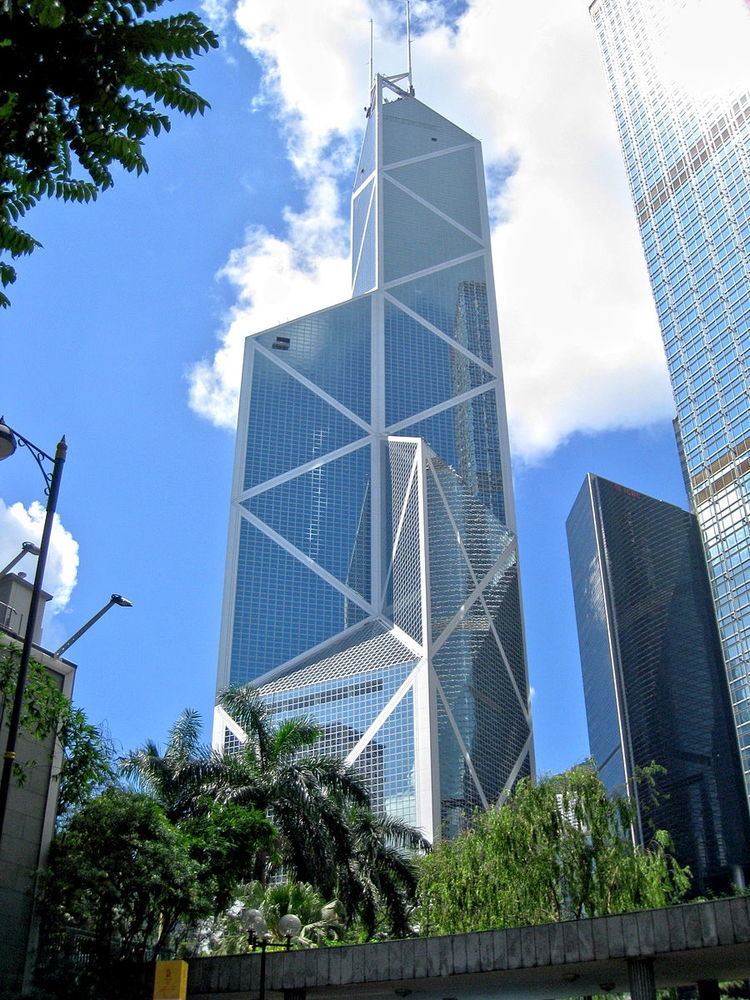Status Complete Completed 1990 Roof 315.0 m (1,033.5 ft) Construction started 18 April 1985 Area 6,700 m² Architect I. M. Pei | Type Commercial offices Opening 17 May 1990 Height 367 m Floors 72 Architectural style High-tech architecture | |
 | ||
Similar Hong Kong and Shanghai, Cheung Kong Center, Bank of China Building, Central Plaza, International Finance Centre | ||
The Bank of China Tower (abbreviated BOC Tower) is one of the most recognisable skyscrapers in Central, Hong Kong. It houses the headquarters for the Bank of China (Hong Kong) Limited. The building is located at 1 Garden Road, in Central and Western District on Hong Kong Island.
Contents
Designed by I. M. Pei and L.C Pei of I.M Pei and Partners, the building is 315.0 m (1,033.5 ft) high with two masts reaching 367.4 m (1,205.4 ft) high. It was the tallest building in Hong Kong and Asia from 1989 to 1992, and it was the first building outside the United States to break the 305 m (1,000 ft) mark. It is now the fourth tallest skyscraper in Hong Kong, after International Commerce Centre, Two International Finance Centre and Central Plaza.
Plot history
The 6,700 m2 (72,000 sq ft) site on which the building is constructed was formerly the location of Murray House. After its brick-by-brick relocation to Stanley, the site was sold by the Government for "only HK$1 billion" in August 1982 amidst growing concern over the future of Hong Kong in the run-up to the transfer of sovereignty.
Once developed, gross floor area was expected to be 100,000 m². The original project was intended for completion on the auspicious date of 8 August 1988. However, owing to project delays, groundbreaking took place in March 1985, almost two years late. It was topped out in 1989, and occupied on 15 June 1990.
The building was initially built by the Hong Kong Branch of the Bank of China; its Garden Road entrance continues to display the name "Bank of China", rather than BOCHK. The top four and the bottom 19 stories are used by the Bank, while the other floors are leased out. Ownership has since been transferred to BOCHK, although the Bank of China has leased back several floors for use by its own operations in Hong Kong.
Favouritism controversy
The Government had apparently given preferential treatment to Chinese companies, and was again criticised for the apparent preferential treatment to the BOCHK.
The price paid was half the amount of the 6,250 m² Admiralty II plot, for which the MTR Corporation paid HK$1.82 billion in cash. The BOC would make initial payment of $60 million, with the rest payable over 13 years at 6% interest. The announcement of the sale was also poorly handled, and a dive in business confidence ensued. The Hang Seng Index fell 80 points, and the HK$ lost 1.5% of its value the next day.
Design
Designed by Pritzker Prize-winning architect I. M. Pei, the building is 315.0 m (1,033.5 ft) high with two masts reaching 367.4 m (1,205.4 ft) high. The 72-story building is located near Central MTR station. This was the tallest building in Hong Kong and Asia from 1990 to 1992, the first building outside the United States to break the 305 m (1,000 ft) mark, and the first composite space frame high-rise building. That also means it was the tallest outside the United States from its completion year, 1990. It is now the fourth tallest skyscraper in Hong Kong, after International Commerce Centre, Two International Finance Centre and Central Plaza.
A small observation deck on the 43rd floor of the building is open to the public.
The structural expressionism adopted in the design of this building resembles growing bamboo shoots, symbolising livelihood and prosperity. The whole structure is supported by the four steel columns at the corners of the building, with the triangular frameworks transferring the weight of the structure onto these four columns. It is covered with glass curtain walls.
While its distinctive look makes it one of Hong Kong's most identifiable landmarks today, it was the source of some controversy at one time, as the bank is the only major building in Hong Kong to have bypassed the convention of consulting with feng shui masters on matters of design prior to construction.
The building has been criticised by some practitioners of feng shui for its sharp edges and its negative symbolism by the numerous 'X' shapes in its original design, though Pei modified the design to some degree before construction following this feedback. The building's profile from some angles resembles that of a meat cleaver This earned it the nickname “一把刀”(Yi Ba Dao) in mandarin literally meaning 'One Knife'
